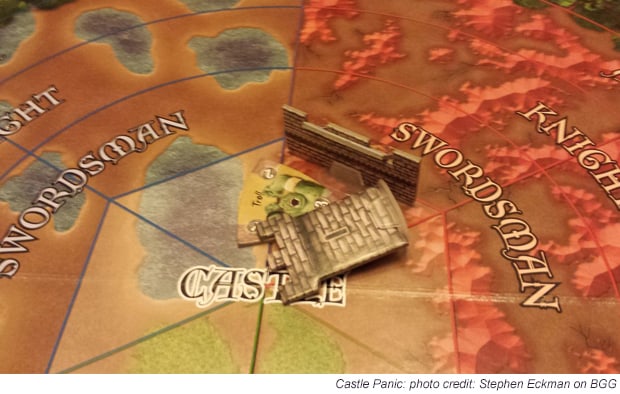
Semi-cooperative Games
With the rise of cooperative games, where all the players work together to achieve a single goal, as in Shadows Over Camelot, it’s no surprise that the term semi-cooperative would eventually pop up. For the rest of the article, I’m going to refer to these as SC’s.
It’s easy to find a lot of these on the internet; just google semi-cooperative. One forum on BGG (Are semi-co-op games flawed?) mentions Divided Republic, CO2, Castle Panic, The Republic of Rome, Legendary, Archipelago, and Arkham Horror, among others. They discuss plusses and minuses of each of these games.
SO WHAT DO WE MEAN WHEN WE SAY “SEMI-COOPERATIVE”
Well, there’s a single nemesis or goal that all the players are striving against or for. It’s possible for all players to lose, or all to win, or some to win. The “semi” comes into play because, despite the fact that everyone has achieved the goal and “won the game”, one player might have more points or kills or whatever at the end of the game, thus making him the
WINNER OF WINNERS
Some say that this is the fatal flaw in an SC, potentially putting players in a reverse king-maker position, knowing that they are going to die in the game, and deciding to take all the other players with them, thus “tying” the game with them. If there is a winner, there is really only one winner, but if everyone loses, then it’s a tie!
There are ways to avoid this conundrum. One is to assure that you can’t die. You can fail to achieve your goal, but still have the most gold, somewhat like the whole global warming trend. I remember trying to design a game based on this idea called Eat the Earth. The game ended when the Earth couldn’t support any life any more. Whoever had the most money at the end won the game. Depressingly real.
Another method is to have the cooperative function built into a normal game, where you have to deal with the other players to get ahead. Competing, yet sharing. Pit, Settlers of Catan, and Bohnanza all share this characteristic, although I’m sure some people will argue that these aren’t SC at all. If you have to share resources to get ahead, then I would call it SC. The primary difference between these and games like CO2 is that there isn’t a condition where everyone loses.
One technique I used in a game design (unpublished) was that a player could escape from the playing board mid-game with whatever resources he had, hoping that none of the other players would get as much as he had. Adventurers uses a similar mechanic. This could easily be used in an SC, eliminating the ability for one losing person to drag down everyone else with him on purpose, out of spite. Of course, the guy who escapes is no longer contributing to the welfare of the others.
I’VE TRIED A NUMBER OF SC VARIATIONS IN MY DESIGNS OVER THE YEARS.
Some of them produced some odd results. The first was an SC dungeon run for real money. I created some D&D pre-fab characters, seeded the dungeon with treasure that had a cash value, and encourage the players to work together to try to get the goodies. The big stuff was completely inaccessible without some cooperation.
Hah.
I don’t think a single player lifted a finger to help the others. Spell carriers who could obviously put a hoard of skeletons to sleep kept their spell to themselves; the most effective use of each item by each player was never applied in a way that helped anyone else, except by accident. In some ways, it was hilarious, but out of 12 players, I think about 6 of them lived, and they didn’t retrieve much treasure. On the plus side, it was a hell of a lot of fun. D&D games are all basically coop games; adding the “semi” to the equation completely changed the dynamics and player interaction in the game.
The second design that featured SC play was a real-time game where players could either move their own team of adventures into a castle, or move the various undead toward their opponents. Players could gather treasure and get points for killing undead. They could work together, wiping out the monsters easily, but the object was to walk the edge of the line, balancing your need to kill off the other players with your need to stay alive and gather treasure. More competitive than coop. I think that when both elements of the game are present, the competitive elements will always rule the cooperative elements. “We can all win, AND I can win the most” always devolves into “I can win”.
The third and most recent design involves a role-playing version of Wiz-War, basically a co-op Wiz-War game, very much like D&D, except with Wizards with megapower and lots of hit points. After playing it the first time, full co-op, which worked extremely well, I thought about adding treasure to the game that players could count as “points”. Still cooperative, but players would be raiding the pockets of the dead opponents, or sneaking into side rooms by themselves to find goodies there before anyone else. I’m not sure the game would be as fun that way, but the added dynamic of greed would certainly make it interesting (or perhaps irritating, for example, rummaging through the pockets of a near-dead companion before curing his wounds).
Yet another game design allowed players to run off the board, stash what they had accumulated thus far, then go back onto the board for another dip into the dungeon. If they died, they could still win based on what they’d stashed with their family.
SO CAN SEMI-COOPERATIVE GAMES WORK?
I think they can, but only in the cases where cooperation helps multiple players, and there are mechanisms that prevent one player dragging all the others down, for instance, not having an “everyone dies” conclusion, or by presenting an escape mechanism for others to save their current status or winnings. And encouraging trade between players so that they help each other during play while vying for the most points themselves is a positive experience allowing both cooperation and competition.







